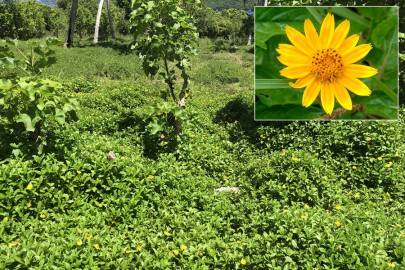Biocontrol for Singapore Daisy in the Pacific?

Singapore daisy invading pasture in Tonga
Singapore daisy was once favoured as a garden and landscaping ornamental, and this has significantly contributed to its distribution within the Pacific region and other parts of its introduced range. Despite its recognition as a significant invader, there is very little legislation on its pest status in the Pacific. This species forms large, dense rhizome mats that can reduce biodiversity and may threaten locally endangered medicinal plants. It is tolerant of a range of environmental conditions, including high salinity, drought, extended flooding, shade, and a variety of pH levels. This adaptability to different conditions means Singapore daisy may have a range of socioeconomic impacts, including food insecurity and loss of income from reduced crop production. The spread of Singapore daisy may be exacerbated by climate change, deepening livelihoods impacts on Pacific peoples. Singapore daisy can reproduce vegetatively from stem fragments and also reproduce sexually, causing it to become dominant in the seed bank. The transport of vegetative parts and the disturbance or transport of soil containing seeds are notable means by which this species is dispersed.
Physical and chemical control methods have been used for combatting Singapore daisy, but they are seldom effective in managing large infestations. Furthermore, both control methods are time and labour intensive and expensive. Control efforts are often futile, as stem fragments can easily take root if not completely removed or destroyed. The costs associated with unsuccessful control campaigns can be extremely high. For example, a control campaign initiated in Niue in 2001 attempted to eradicate Singapore daisy from 35 sites in 11 villages, at a cost of approximately $30,000. However, the programme was unsuccessful as the weed was later found in an additional 52 sites in 13 villages. The ineffectiveness of physical and chemical control methods leaves biocontrol as the only viable control option.
“Singapore daisy has not been targeted for biocontrol before, and there has been very little research on the natural enemies associated with this weed species in both its native and introduced ranges,” said Chris McGrannachan, who led the feasibility study. Chris and Chantal Probst have identified in the literature six arthropods that feed on the weed and 14 fungal species associated with it. Of all the species identified only one fungus (Endophyllum wedeliae) from Jamaica is considered a promising candidate biocontrol agent. Jamaica is an ideal place to conduct initial surveys as Manaaki Whenua has established connections with the University of West Indies, which has assisted with surveying potential biocontrol agents for other Pacific weeds as recently as November 2019. However, given that no targeted surveys of natural enemies associated with Singapore daisy have been conducted, more widespread surveys throughout its distribution range will most likely be necessary. This will maximise the chances of locating host-specific natural enemies that can be considered for biocontrol of Singapore daisy. If successful, biocontrol of Singapore daisy in the Pacific region will help to curb biodiversity loss and protect natural ecosystems that are threatened by this prolific invader.
Funding
This project is funded by the Ministry of Foreign Affairs and Trade.
Key contact

